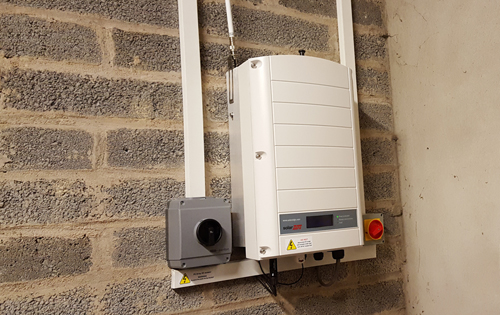Solar Inverters
Solar Panel Inverters - An Introduction
 Solar inverters are really the heart of a grid-connected solar panel system. They are arguably the most important component, more so than the panels themselves. The solar panel inverter’s main job is to take the DC (Direct Current) electricity from the solar panels and convert it into AC (Alternating Current) electricity that can be used by electrical appliances in the building or exported to the national grid.
Solar inverters are really the heart of a grid-connected solar panel system. They are arguably the most important component, more so than the panels themselves. The solar panel inverter’s main job is to take the DC (Direct Current) electricity from the solar panels and convert it into AC (Alternating Current) electricity that can be used by electrical appliances in the building or exported to the national grid.
The inverter often also acts as a monitoring system, connecting to the internet and uploading the performance data for viewing in a web browser.
See our article on solar panel monitoring.
Solar Inverters are the most likely component in the solar panel system to have technical issues and one of the most expensive to replace. Because of this it is vital to choose:
-
a high quality, reliable solar inverter
-
an established solar inverter manufacturer that will be around in years to come
-
a manufacturer with a technical support office in the UK
-
an inverter with a good warranty period
Issues that are less important than the above but are often used as selling points are the inverters start-up voltages and inverter efficiencies. In a high quality inverter these will always be very good even if the data sheets of a less established inverter manufacturer shows better figures. Any technical differences like this are normally minimal and not worth considering when making a decision - far better to go with an proven manufacturer with a good reputation for realiable, quality inverters.
Exeo Energy staff have many year of experience working with inverter manufacturers and can help you to choose the best inverter for you and your property.
In the majority of grid-connected systems the inverter will shut the solar panels down if there is a power cut to prevent any electricity being exported which could cause a safety issue to any engineers who are trying to fix the power cut. Because of this most solar panels will not work in a power cut. It is possible to design systems that are grid connected and can also work in a power cut but these systems require additional components and a there is normally a significant increase in the cost of the solar panel system.
There are four main types of solar inverter used in grid-connect systems:
-
String inverter – this is where the panels are all connected together in a long string which feeds back to the inverter. This type inverter can have a number of strings and sometimes more than one MPPT tracker. With this type of system if you have shading over one panel it effects the performance of all the panels in the same string. Examples of string inverter include SMA, SoFar Solar and Fronus.
-
String inverter with power optimisers – this is where each panel is optimised independently. Each panel is connected to its own optimiser (sometimes is pairs) mounted on the roof and the optmisers are connected together in a string that feeds back to the inverter. With this system you can have panels facing different direction, at different pitches and with different levels of shade without the same loss of production you would get with a string inverter. The market leader for inverters with power optimisers is Solar Edge. Note: do not confuse power optimisers with Voltage Optimisers.
-
Micro-inverters - these are small individual inverters which are mounted behind each panel on the roof. Similar to the power optimisers these are useful if there are shading issues or you have panels facing different directions. Micro-inverters are particularly useful when a system is very small, for example is made up of only 2-3 panels or if there is no suitable location to install a string inverter.
-
Hybrid inverters – These are string inverters with battery banks integrated into the inverter. These work the same as a string inverter but they also store excess energy that is generated during the day and discharge this energy at night when there is no solar energy available but there is still electrical energy consumption in the property.
Both the power optimisers and the micro-inverters require electronics to be roof mounted and although they have good warranties there is a small chance of issues. Therefore if the panels are mounted in a location that is particularly difficult to access in future it makes sense to avoid either of these technologies and to stick to the simpler string inverter.
Solar Panel Manufacturers
Based on our many years of experience in the solar photovoltaic industry we have our prefered manufacturers that we tend to use in most situations because we know they are reliable, will work well for years to come, are productive and have great UK based support.
- SMA - The leading inverter manufacturer, based in Germany. Manufactures string inverters for domestic, commercial and utility scale sysems.
- Solar Edge - The leading manufacturer of power optimised inverters.
- Enphase - The leading manufacturer of micro-inverters, based in the US.

